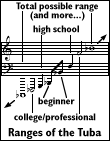
Harrison Greene
Wind Ensemble
Temple High School






 |
Like
the euphonium, the tuba is a hidden talent - often relegated to a simple
"oom-pah-pah" type bass line, and rarely called upon for solos. However,
the tuba is an extremely capable instrument, less nimble than smaller instruments
but capable of a range of expression as wide as any other instrument and
more than most - from soft and lyrical to loud and bombastic and even fast
and complex. With a total range of four octaves (and more - unmatched by
most other instruments), the tuba has a lot to offer that hasn't yet been
fully utilized.
Some HistorySince then, the general design has remained the same, but some interesting variations have appeared, including four, five and six valve instruments, rotary valves, fiberglass sousaphones and convertible tubas, designed exclusively to be used as both marching and concert instruments. Tubas can now be found in the most diverse range of shapes and designs of ANY instrument, and the number increases drastically when tenor tubas (another name for the euphonium) are added. Tubas can come in five different keys (BBb, CC, Eb, F, and the GG contrabass bugle), bell up or front, bells fourteen to thirty inches in diameter, lacquered or silver plated, rotary or piston valves (or both), two to six valves, convertible or student or professional models. Sousaphones add to that, as do tenor tubas (baritone or euphonium, bell up or front, one or two bells(the rarely-seen double-belled euphonium), three or four valves, compensating or non, silver or brass), obsolete instruments (ophicleide, bass saxhorn), and the ambiguous Wagner tuba. To see all this variety, one need only attend a Tubachristmas - the selection of instruments people bring to play is simply staggering. |



|